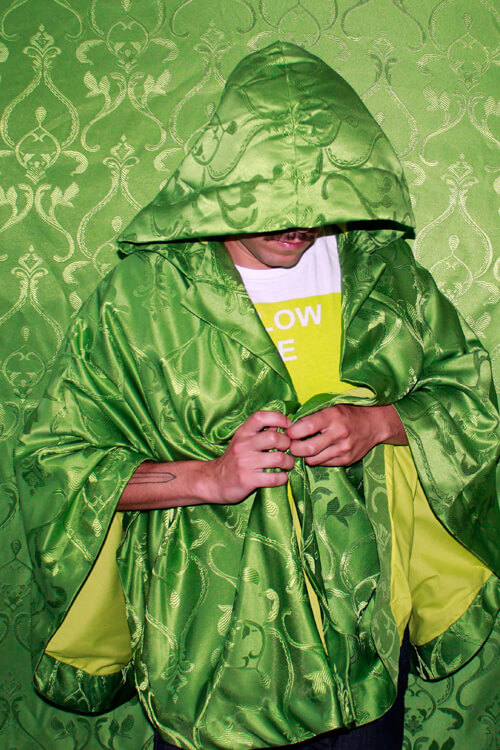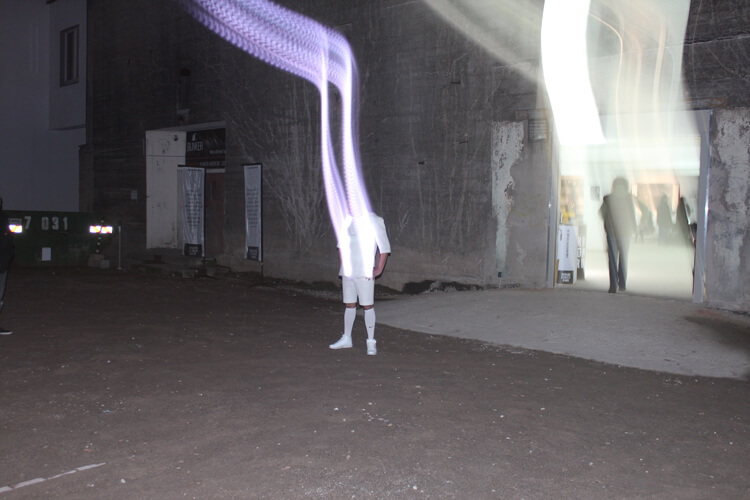Words by Meritxell Rosell

To bring about sensorial experiences through digital interaction: that’s one of the main creative aims of Ricardo O’Nascimento. An artist and researcher in the field of new media and interactive art, he investigates the relationship between the body and environment, developing interfaces for worn devices, interactive installations and hybrid environments. Keeping a poetic approach in mind, he wants to make people dream by putting fashion on another level of expression heightened by technological advance
O’Nascimento is also the founder of POPKALAB – his experimental project – a design studio focused on research and innovation in wearable technology: we are specialised in electronic textiles and reactive garments for entertainment and lifestyle. Through this project, he’s been able to establish thriving collaborations with a number of talented artists and designers and to present his projects all over the world in museums, galleries and art festivals like Ars Electronica, V2 and Transmediale.
Based in Rotterdam, O’Nascimento has a background in political sciences which has given him an inquisitive sight of human and social behaviour His designs are exuberant, playful, full of life and colour, probably a reflection of Brazilian culture and a love for indigenous aesthetics.
In Batuque – one of his most recent creations and inspired by the Afro-Brazilian faith Candomblé – the wearer becomes a sort of entity with an extra sense. Its skin senses the surround sound and reacts with movements and vibrations.
Ricardo is also very prolific in collaborative projects, like Be Loved, with Iria do Castelo, a piece of work that tries to find the boundaries of love and borders of attraction, where being tied to someone becomes an expression of freedom. Other of his creations, like Wearable Narratives and Wearable Façade, explore different aspects of communication and interaction through clothing apparel, either with other human beings or the space around us.
With designs that aim to make us feel and experience new sensations as if they were part of our bodies, Ricardo shines a ray of light in our sometimes not-so-sunny lives.




What drew you to working at the intersection of new media, interactive art, wearable devices, and interactive installations? Could you tell us a little bit about the intellectual process?
My background is in political sciences. When I was living in Brazil, I used to work for an NGO that, among other things, fought for the rights of indigenous people. While working there, I realised that my heart is in their aesthetics and art. I understood that art could be a powerful tool to convey a message and perhaps more efficient than writing papers.
I am a musician myself, and I always was interested in synthesisers and electronic devices. I guess that is why I got interested in interactive art. For me, magic happens when you can participate in the artwork. My pieces are open, and depending on the way you interact, they will behave in a particular way. This proximity to the visitor is crucial to me.
When you make an interactive piece, you must think about the user and how he/she could behave when confronted with the artwork. This thought puts the body in a very prominent place. Without the body, there is no interaction. Wearable devices came naturally. Since I was a kid, I have been very interested in fashion as a self-expression tool. With technology, you can add a new level to it. Today, with the use of electronics and smart components such as microprocessors, sensors and actuators, clothes have become intelligent. They start to respond to their environment and establish communication at many different levels. The possibilities that new type of technology bring is immense and very appealing to me.
ASVOFF9 will launch the world’s first Wearable Technology in Fashion Film Competition. The competition will be a game-changer in the world of humanistic intelligence-inspired / art-based wearable technology by communicating the real potential of wearable technology to the world through film. What impact do you think the festival is going to have on the future of wearable technologies?
I hope the festival shows the big public that wearable technology can be much more than gadgets that we are used to seeing in magazines. I believe it can present more artistic performances related to wearable technology. I want to see works that are not necessarily trying to hit the market and raise millions but, instead, works that are compromised with artistic values and subjectivity.
Wearable technologies have the ability to communicate with their owners, and by doing so, the boundaries between physical and digital are blurring. How people respond to multiple stimuli in a digital environment beyond the touch of a screen or button is one of the questions to answer in this 21st century in which people live in a hyper-connected society. In which ways do you think are interactive and digital technologies changing or affecting human behaviour?
It is fascinating how we are delegating part of our lives to electronic devices. The smartphone, for instance, is now an essential apparatus, and people get nervous when it is not around. Indeed, wearable technology can provide an even more immersive digital experience to the user. When you no not need anymore to look at the screen to interact with the information, you potentially become more efficient and maybe more stressed.
The over information that we are exposed to tends now to hit other senses than vision. For instance, with the use of haptic feedback, the wearer can feel the information on the skin. Fortunately, our brain is smart enough to adapt itself to this new stimulus. I believe wearable technology will play a significant role in the next years by freeing people from the square of the screen and proposing new forms of interaction.
What are the biggest challenges you face in your projects?
The biggest challenge for me it is still the connection between the soft and hard parts. The fact that the body moves a lot and sometimes in a non-predictable way stresses the electronic circuit and ends up breaking. The challenge is how to integrate the technology fully and not only create pockets to host the electronics.
Another struggle is the fact that I am an independent artist. Not having an institution behind me can sometimes be a problem. Although I see myself as an artist, I am aware of the commercial possibilities brought by wearable technology, and from my experience, big companies rarely contact an independent artist to collaborate with their R & D team.
You couldn’t live without…
That is a hard question. I think I could not live without dreaming.






